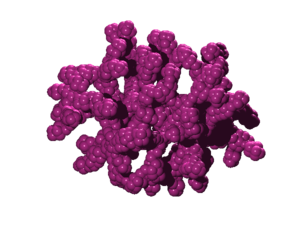Dendrimers: Difference between revisions
Carl McBride (talk | contribs) (→Radius of gyration: Added Chen-Cui result) |
Carl McBride (talk | contribs) m (Added dendron in greek) |
||
| Line 1: | Line 1: | ||
[[Image:single_dendrimer.png|thumb|right|A single dendrimer molecule (G4 [[PAMAM (dendrimer) | PAMAM]], solvent not shown)]] | [[Image:single_dendrimer.png|thumb|right|A single dendrimer molecule (G4 [[PAMAM (dendrimer) | PAMAM]], solvent not shown)]] | ||
'''Dendrimers'''. Dendrimers can be characterised by three parameters: functionality (<math>f</math>), spacer length (<math>P</math>) and number of generations (<math>G</math>). The number of monomers (<math>N</math>) in a dendrimer is given by | '''Dendrimers''' (from the aincient greek δένδρον, meaning tree) . Dendrimers can be characterised by three parameters: functionality (<math>f</math>), spacer length (<math>P</math>) and number of generations (<math>G</math>). The number of monomers (<math>N</math>) in a dendrimer is given by | ||
:<math>N= 1 +fP \frac{(f-1)^{G+1}-1}{f-2}</math> | :<math>N= 1 +fP \frac{(f-1)^{G+1}-1}{f-2}</math> | ||
Revision as of 14:11, 5 March 2014

Dendrimers (from the aincient greek δένδρον, meaning tree) . Dendrimers can be characterised by three parameters: functionality (), spacer length () and number of generations (). The number of monomers () in a dendrimer is given by
Density profile
Dense shell model
de Gennes and Hervet [1] calculated that for self-avoiding dendrimers in a good solvent, the density profile increases from a minimum at the centre of the dendrimer to a maximum at its outer surface, i.e. a dense outer shell with a hollow centre. Note this leads to a limit of
However, recent work by Zook and Pickett [2] has shown that the de Gennes and Hervet model was flawed.
Dense core model
Most studies support the dense core model of Lescanec and Muthukumar[3] despite early uptake of the dense shell model. Boris and Rubinstein pointed out that the structure of the dendrimer is a result of the competition between the entropy and excluded volume [4], neither of which terms favouring a hollow centre.
Radius of gyration
It has been suggested that the radius of gyration () scales as [5]
where is the number of monomers. This implies a compact structure.
Ideal dendrimer
For an ideal dendrimer, consisting of non-interacting monomers, is given by [6]
Chen-Cui scaling law
The Chen-Cui scaling law is given by [7]:
where is the Flory exponent.
Specific dendrimers
- Carbosilane
- PAMAM (also known as STARBURST®)
- PBzE poly(benzyl ether)
- PPI (polypropylenimine)
- Tecto dendrimers
See also
References
- ↑ P. G. de Gennes and H. Hervet "Statistics of «starburst» polymers", Journal de Physique Lettres 44 pp. 351-360 (1983)
- ↑ Thomas C. Zook and Galen T. Pickett "Hollow-Core Dendrimers Revisited", Physical Review Letters 90 015502 (2003)
- ↑ Robert L. Lescanec and M. Muthukumar "Configurational characteristics and scaling behavior of starburst molecules: a computational study", Macromolecules 23 pp. 2280-2288 (1990)
- ↑ David Boris and Michael Rubinstein "A Self-Consistent Mean Field Model of a Starburst Dendrimer: Dense Core vs Dense Shell", Macromolecules 29 pp. 7251-7260 (1996)
- ↑ Michael Murat and Gary S. Grest "Molecular Dynamics Study of Dendrimer Molecules in Solvents of Varying Quality", Macromolecules 29 pp.1278–1285 (1996)
- ↑ Wilfried Carl "A Monte Carlo study of model dendrimers", Journal of the Chemical Society, Faraday Transactions 92 pp. 4151-4154 (1996)
- ↑ Zheng Yu Chen and Shi-Min Cui "Monte Carlo Simulations of Star-Burst Dendrimers", Macromolecules 29 pp. 7943-7952 (1996)
- Related reading
- Matthias Ballauff and Christos N. Likos "Dendrimers in Solution: Insight from Theory and Simulation", Angewandte Chemie International Edition 43 pp. 2998-3020 (2004)
- M. R. Wilson, J. M. Ilnytskyi, L. M. Stimson and Z. E. Hughes "Computer simulations of liquid crystal polymers and dendrimers" in Computer Simulations of liquid crystals and polymers, eds. Pasini P., Zannoni C. and Zŭmer S., Kluwer pp. 57-78 (2004) (preprint)
- Mark R. Wilson, Lorna M. Stimson and Jaroslav M. Ilnytskyi "The influence of lateral and terminal substitution on the structure of a liquid crystal dendrimer in nematic solution: A computer simulation study", Liquid Crystals 33 pp. 1167 - 1175 (2006)
- Juan J. Freire "Realistic numerical simulations of dendrimer molecules", Soft Matter 4 pp. 2139-2143 (2008)
- Gustavo Del Río Echenique, Ricardo Rodríguez Schmidt, Juan J. Freire, José G. Hernández Cifre and José García de la Torre "A Multiscale Scheme for the Simulation of Conformational and Solution Properties of Different Dendrimer Molecules", Journal of the American Chemical Society (JACS) 131 pp. 8548-8556 (2009)
- J. M. Ilnytskyi, J. S. Lintuvuori, M. R. Wilson "Simulation of bulk phases formed by polyphilic liquid crystal dendrimers", Condensed Matter Physics 13 pp. 33001:1-16 (2010)











